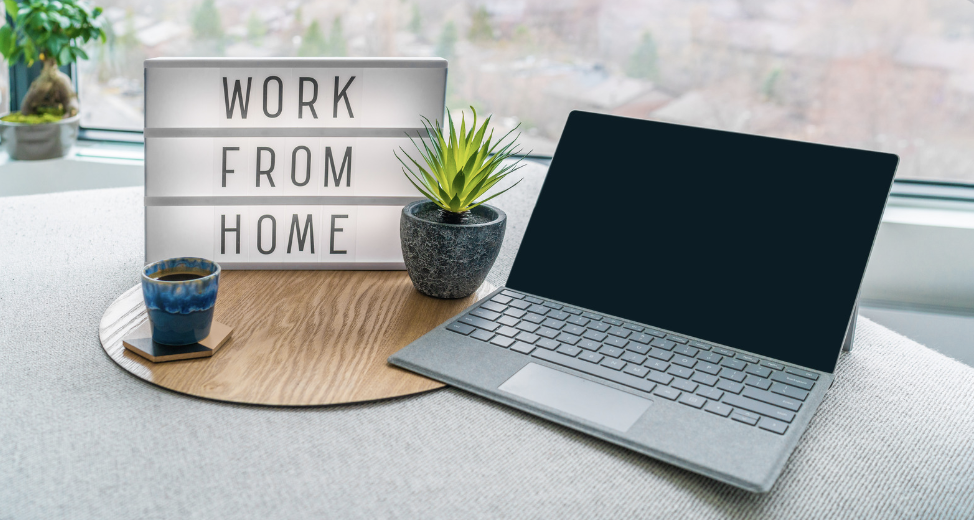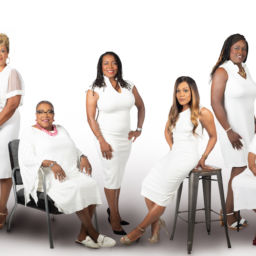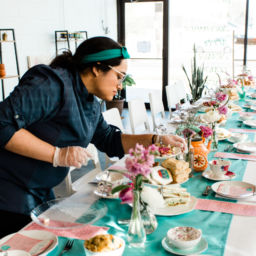
Most workers have had a taste of remote work during the past two years. Like it or hate it, the new landscape represents not only a change in work itself, but a paradigm shift in the jobs and types of companies available.
Seventy percent of workers say they want a hybrid or remote working style post-pandemic — and employers are listening. Many Indianapolis workers now have a hybrid option, but what about fully remote?
We talked with three women who have taken the leap to a fully remote role with no office in Indiana. These women are quietly changing the tech we use and know every day from their home offices. They’ve shared their journey, the benefits and challenges of a remote job, and tips for evaluating remote opportunities.
STEPHANIE BRECHBUHL, SENIOR PRODUCT DESIGNER, ETSY

If you love to buy from Etsy like I do, then you’ve likely had a purchasing experience influenced by Stephanie Brechbuhl. Brechbuhl’s design career started as early as high school, and she worked her way through marketing, web design, and front-end development roles before landing in product design at Salesforce.
Brechbuhl’s latest contract is as a Senior Product Designer at Etsy, where she leads the research and execution of design systems for web experiences for the company. She also produces documentation around accessibility best practices for Etsy’s design systems, making sure that the platform’s usable for anyone with a disability such as visual impairment.
ANNA SARACENO, EXPERIENCE DESIGN MANAGER, TRELLO AT ATLASSIAN

After earning her B.S. in Public Health, Anna Saraceno wanted to work in public health education. What changed her mind was her campus job at Indiana University — working at IU’s IT support services. Through that job, she fell in love with the tech field and helping people problem-solve and use technology to its most valuable extent.
Saraceno worked in technical writing and earned a master’s in Human-Computer Interaction, then landed in product management and User Experience (UX) design, where she’s spent over a decade. After working at smaller startups, scale-ups, and Salesforce, she’s now in her fifth year in product design at Trello and just started in a design management role for the project-management software.
DESTINY LOYD, LIFECYCLE & EMAIL MARKETING MANAGER AT APPTIO

An Indiana State University graduate, Destiny Loyd started out in radio promotions and ran her own PR company before working in event planning, where she discovered a love for email marketing.
As the Lifecycle and Email Marketing Manager for Apptio, she manages email projects for the global IT company. On a typical day, she collaborates with other departments to plan content to promote, communicates needs to content writers, and packages everything for handoff to marketing operations.
REMOTE WORK Q&A: THE GOOD, THE BAD, AND THE UNEXPECTED
Brechbuhl, Saraceno, and Loyd open up about what it’s like to wake up and “go” to work every day without coworkers, a commute, or an office coffee pot.
At what point did you launch into working fully remote, and why?
Loyd: Remote work was not something I saw myself doing. In March 2020, I was working for Project Lead The Way and left on a Thursday to go out of town with friends, and never went back to that office. I started at my current job in 2021.
Brechbuhl: During the pandemic, like everyone, I was forced to be remote. I have a love/hate relationship with being remote! If I had the option, I would go into a place of work sometimes because I like the interaction. In the big picture, I chose a remote job because there are so many more opportunities as a remote designer. You can work anywhere, at any company, and have access to a wider variety of industries.
Saraceno: Trello has been a remote company since its inception, so I’ve been fully remote since joining four-and-a-half years ago. Remote work was a huge selling point for the position at Trello. At the time, my wife and I had recently completed foster parent certification and were in the process of being placed with two boys (ages three and five at the time) who needed a home with the plan of eventual adoption. For those unfamiliar with foster parenthood, it involves a ton of appointments and meetings, many of which are last-minute or beyond your control in terms of time or location.
Working remotely also meant that time otherwise spent in a commute could instead be spent bonding with the boys or doing one of the myriad other parenting things that needed to be done. Ultimately, working from home instead of an office removed a layer of complexity from a stressful family life situation.
What’s it like to work with a team that you’ve never or rarely met?
Loyd: It is different. My company’s a global team and I’m the only person that works in Indiana. I’ve met my U.S.-based team once. Meeting scheduling is a challenge because people are on different time zones. You sometimes have to take meetings late at night or early in the mornings. We live and die by Slack and we also use Smartsheet (their project management software) to stay on top of projects.
Brechbuhl: It can be challenging. You have to try to find moments where you can create connections that are not work-related. You have to be very intentional about creating time and space for those connections so you can then build a relationship to do really great, awesome work. I’ve been to Brooklyn once to meet the people I work with. It was really fun to see people in the flesh versus on the screen.
Saraceno: I’d say “fantastic,” with a side of “challenging at times.” We at Trello are very intentional about how we remotely communicate and interact in both social and work-focused capacities.
Given Trello’s remote-first culture since the beginning, there are many aspects of our practices that facilitate meaningful relationships, team cohesion, and productive work. Most teams at Trello have weekly remote social sessions, for example. I remember the first remote-centered practice I learned about at Trello was that during meetings, if even one attendee is remote then all attendees must join the meeting remotely to level the communications playing field.
Prior to the pandemic, teams typically gathered in person at an Atlassian office two or three times per year. This in-person time was also a crucial element to team cohesion. Throughout the height of the pandemic, we really felt the impact from not having this in-person time, as these onsite sessions always brought renewed energy and connection within our teams. Trello did some incredible things to try to make up for this loss, including giving everyone an Oculus and having a huge Trello-wide event where we could interact in VR (along with a VR mini golf tournament!).
What’s the best part of working remotely?
Brechbuhl: I like the flexibility it brings with kids and a busy life. I have more time in the mornings and evenings. I find that I can focus better because I have less distractions (although there are home distractions!).
Saraceno: Functionally speaking, the best part of working remotely is the convenience and flexibility offered by not having a commute or being forced to spend eight hours of your day away from your house — but I always have the option of a coffee shop or coworking space, which is great.
Culturally speaking, the best part of working remotely is that it is the truest form of bringing your whole self to work. I absolutely love getting a glimpse into colleagues’ home offices, getting a feel for their style and interests, and seeing pets, kids, and spouses walk through the Zoom background. I have a bunch of guitars hanging on the wall behind my desk and often have a cat or dog creeping around my office, so there is always a conversation starter nearby.
How do you think your career or life would be different if you hadn’t had the opportunity to work remotely?
Saraceno: Simple: I’d be way more stressed out in both my personal and professional life. Remote work has given me extra flexibility to face the challenges of things like foster parenthood and dealing with remote learning during the pandemic. It also gives me more control over my physical environment, often helping me feel more productive and focused than I otherwise would in an open office.
Loyd: My life would be a lot more hectic. I would not have the flexibility and freedom to explore the things I want to do. Now, I can go to the gym in the mornings because I work from home. I can run errands and get things done that make my life easier. I can join a Zoom call from my phone anywhere.
What advice do you have for Indianapolis women exploring remote job opportunities?
Loyd: If you’ve never gone remote, explore a hybrid model first to see if it’s a fit for you. Be open to the opportunity and be clear about your priorities and responsibilities in your schedule. You need to set a routine and utilize your calendar, and be on top of managing yourself and your time. It’s very easy to get distracted: I find myself in the kitchen a lot!
Saraceno: I recommend thinking about how you can grow your online presence in a way that demonstrates your aptitude for remote communication and collaboration. You can start small by buffing up your LinkedIn profile and thinking about how a recruiter for a remote position may look at it. Consider writing short blog posts about your area of expertise or creating a portfolio site for yourself on something like SquareSpace or Wix. Demonstrate your aptitude for a strong remote presence before you even apply for a remote position.
How can you determine if a company is truly supportive and inclusive of remote workers?
Saraceno: You really have to talk with someone within the company to get a realistic feel for whether or not the company has truly remote-centered practices. A company may claim to be remote-friendly, but you’ll find yourself one of two people dialed into a call with 10 other people in a conference room, unable to hear the asides happening between the main topics of conversation.
In interviews, I would look for signs that they are proactive and intentional about relationship building and team cohesion, and ultimately that they have a high level of trust in employees to do their best work because of the remote-friendly culture, not in spite of it.
Brechbuhl: I’d definitely do research on Glassdoor and on the company’s careers page to get the sense of their remote work culture. In interviews, ask about their meeting cadence, their in-person vs. remote breakdown, and what kind of groups the company has for remote workers.
EVALUATING OPTIONS FOR YOUR NEXT CAREER OPPORTUNITY
When making a career change in the past, options used to be fairly straightforward. Your market has companies A, B, and C in a certain industry. Even in a town of Indianapolis’s size, your industry may feel small, and job or leadership opportunities may be limited.
The increase of remote roles means many more opportunities — but that can be overwhelming to even know where to start with a job search. Here are three questions to ask yourself to determine if a fully remote role is for you and how to start:
- What’s my experience with remote work?
If you’ve worked hybrid or remote in some capacity, how did it work for you? If your experience was negative, why was that? Would better resourcing, tools or culture make a difference at another company? - What am I looking for that I can’t find locally?
Is there a specific industry or role that’s difficult to find in Indianapolis? Are you looking for a better pay rate that comes with some other markets? If you can’t answer this question, you may be better off looking for a hybrid or remote-friendly job that’s local. Narrowing your focus can also help you weed through thousands of remote job postings to find ones that are a fit for you. - Can I design an environment and daily rhythms for productivity?
How’s your self-discipline? With remote work, you can’t depend on office cues for when it’s time to eat lunch, take a break, or quit working for the day. Think about what you’ll need to make a functional home office or coworking space and what rhythms you’ll take (walk the dog? meditation breaks?) to keep yourself productive and healthy.
Just as remote work isn’t the same at all companies, it isn’t the same experience for everyone. If you decide to try it, take time to refine your remote working style, practice open communication, and be gracious with yourself and your coworkers. If you can get past the initial challenges, you can reap the personal and professional rewards.
“I love remote work. I advocate for it with a lot of my friends, but it’s not for everybody,” said Loyd. “Productivity is not about where you are when you’re doing the work, it’s about doing the work.”
Mandy Bray is a freelance writer covering marketing, technology, and careers. When not hunched over her laptop, you can usually find Mandy in the kitchen cooking, out on a trail, or with her nose in a book. You can connect with her on LinkedIn, Twitter, and her website.
All of our content—including this article—is completely free. However, we’d love if you would please consider supporting our journalism with an Indy Maven membership.




















